After tiding over the initial bugs and instabilities and a couple of updates later, we are ready with our OnePlus 9 review. Other than the usual analysis of key aspects of the phone, we will also look to answer commonly asked questions like “Is Hasselblad truly a magic wand or just a marketing gimmick?”, “Does the OnePlus 9 justify its higher price tag?” and more. If you are wondering what’s different in this new device as compared to the OnePlus 8T (Review), you may want to read this before you proceed. Time to jump into the action.
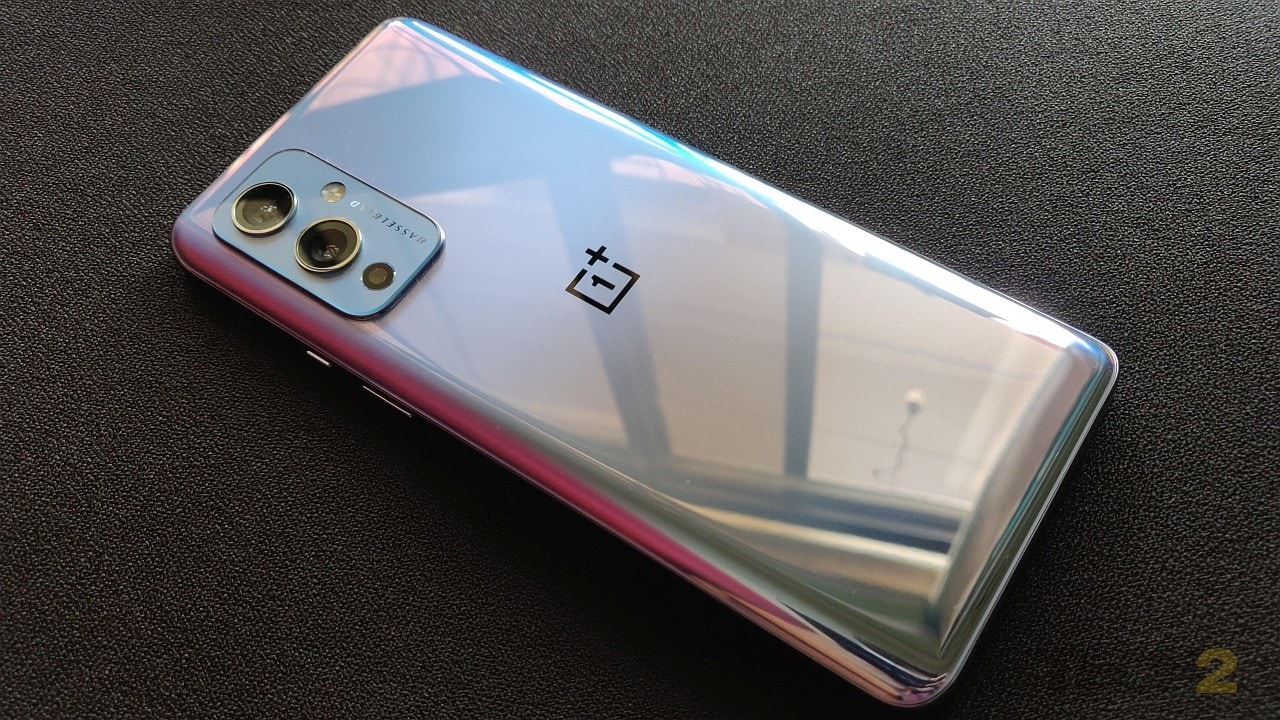
OnePlus 9. Image: Tech2/Ameya Dalvi
OnePlus 9 Design: Sleeker and lighter but with a plastic frame
The OnePlus 9 and 8T look identical from the front, with a minimal chin and a punch-hole at the top left of the screen for the selfie camera. The back looks a little different, with the use of colour gradient this time instead of the uniform texture on the 8T. We got the Winter Mist colour variant for review, which has light purple hues in natural light, and the shade changes depending on the viewing angle and ambient lighting in the room. It does look cool and classy. While the positioning of the rear camera module is similar to the 8T’s, the number of lenses and their alignment are both different.
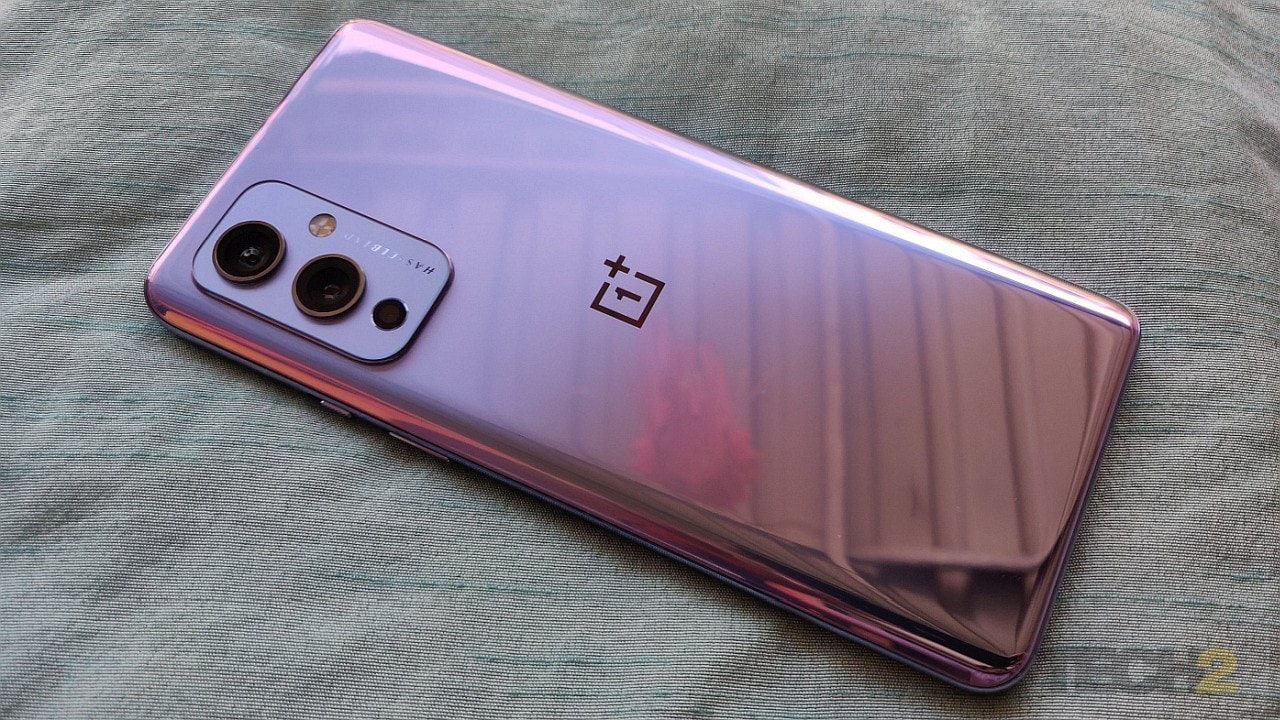
It does look cool and classy. Image: Tech2/Ameya Dalvi
The edges on the OnePlus 9 are narrower, and make the phone feel slimmer than it is; the phone feels good to hold. Even otherwise, the phone is 0.3 mm slimmer than the 8T, but the company has opted for a gloss finish instead of matte along the periphery, which attracts a lot of smudge marks. In order to keep the weight down (183 gm), the company has done away with the metal frame present on most OnePlus phones and replaced it with plastic. While it doesn’t feel plasticky to touch, it does put a question mark on the phone’s durability. Having a plastic frame on the sub-Rs 30,000 Nord was fine but doesn’t feel right on a Rs 50,000 device.
You get an in-display fingerprint scanner, but unlike the OnePlus 8 or 8T (where it was placed a little higher than usual for easier access), they have dropped it a centimetre or two lower on the 9, and you have to strain your thumb to reach it. I wonder what necessitated this. The scanner is highly responsive, though, and worked perfectly fine. The SIM tray is present along the bottom edge of the phone, and it can accommodate up to two nano-SIMs. The OnePlus 9 is 5G-ready. Till we have 5G here, you can use up to two 4G SIMs. Next to the SIM tray are a USB-C port and the phone speaker. The volume rocker is placed along the left edge (and a little lower, which is good) and the power button is located on the right edge along with the alert slider.
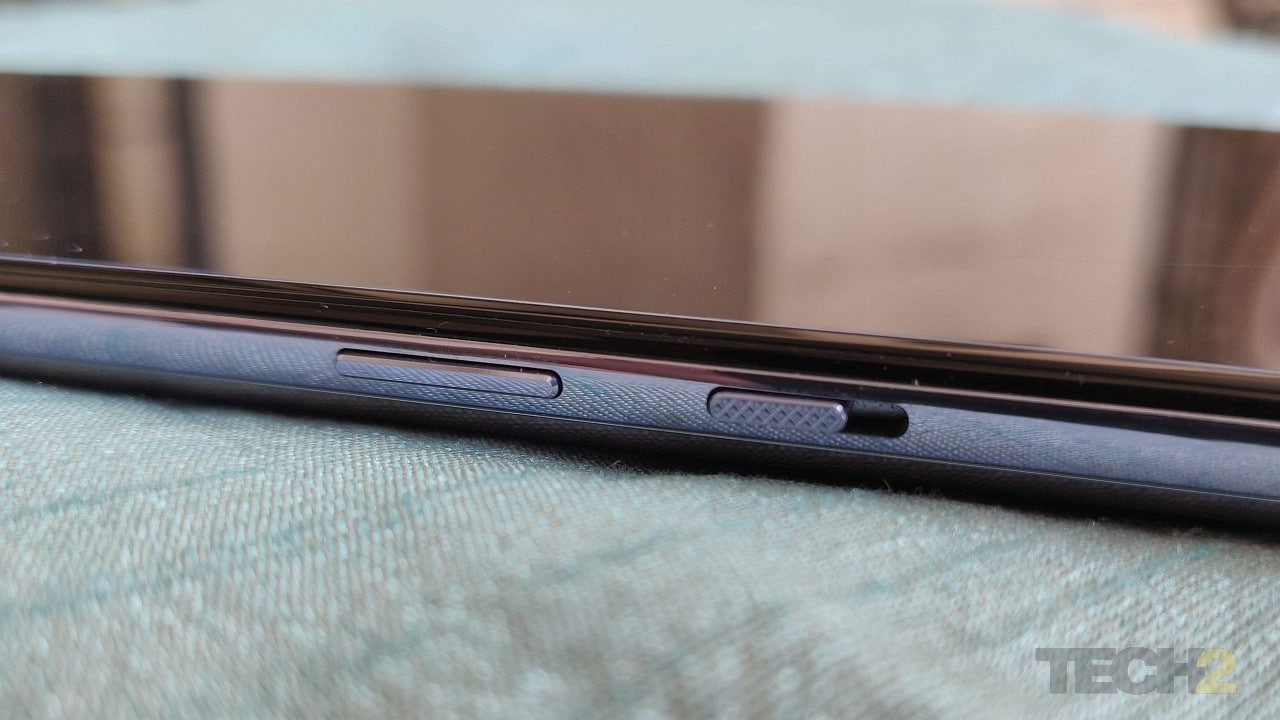
The volume rocker is placed along the left edge (and a little lower, which is good) and the power button is located on the right edge along with the alert slider. Image: Tech2/Ameya Dalvi
OnePlus 9 key specifications
- Qualcomm Snapdragon 888 SoC
- Adreno 660 GPU
- 8 GB or 12 GB RAM options
- 128 GB or 256 GB UFS 3.1 internal storage
- 55-inch Full HD+ (2400 x 1080) Fluid AMOLED display with 120 Hz refresh rate, HDR10+ and Corning Gorilla Glass
- Cameras: 48MP with PDAF (wide) + 50MP (ultrawide) + 2 MP (Monochrome); 16MP (wide) selfie camera
- 4,500 mAh battery with bundled 65 W fast charger
- Android 11 with OxygenOS 11
- 5G-compliant; Bluetooth 5.2; Dual band WiFi a/b/g/n/ac/6
OnePlus 9 price in India
Rs 49,999 for 8 GB RAM with 128 GB internal storage
Rs 54,999 for 12 GB RAM with 256 GB internal storage
OnePlus 9 display: If it ain’t broke, don’t fix it
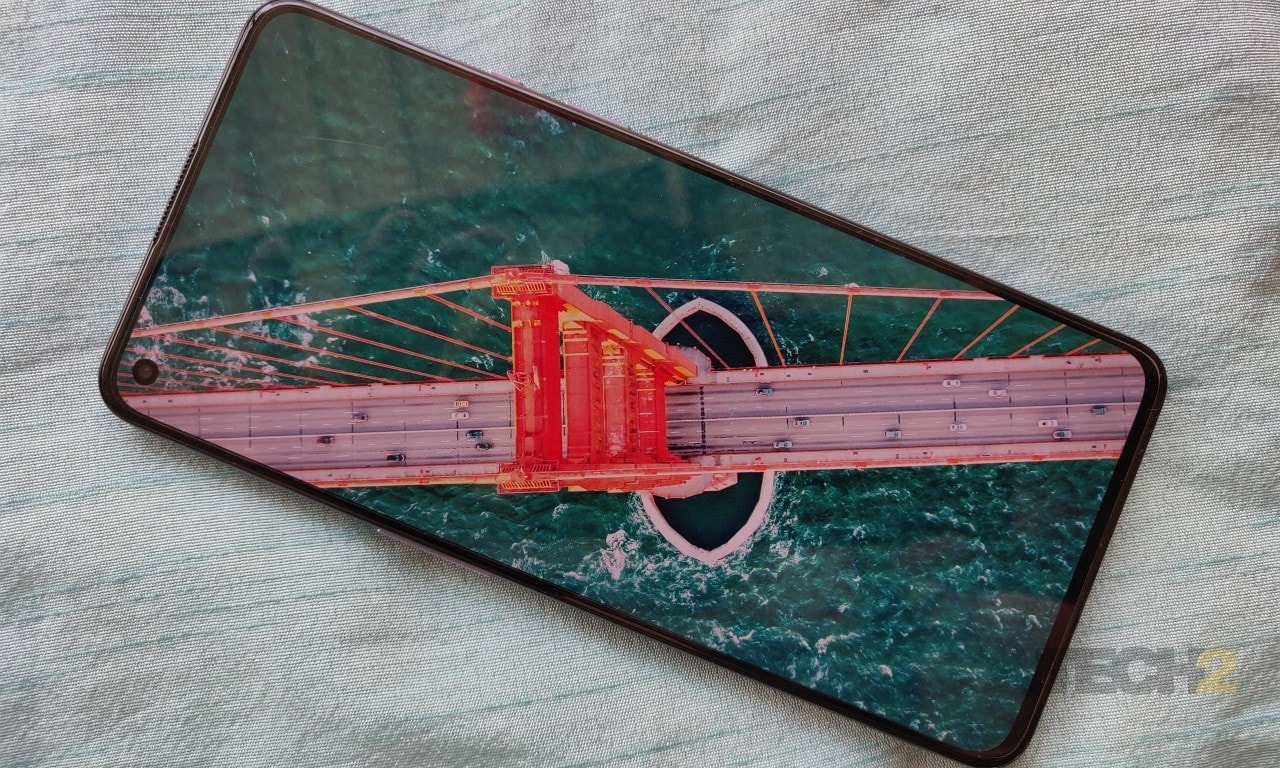
Black levels and contrast are excellent, given that it’s an AMOLED screen, and colour reproduction is quite good in Vivid as well as Natural mode. Image: Tech2/Ameya Dalvi
The OnePlus 9’s screen is almost identical to that of the 8T. It is a 6.55-inch, Fluid AMOLED display with a resolution of 2400 x 1080 pixels, 120 Hz refresh rate and peak brightness of 1,100 nits. The display is extremely vibrant and super smooth when scrolling through compatible apps. You get an option to switch the refresh rate from 120 Hz to 60 Hz to save battery, but just leave it at 120 Hz. It switches to 60 Hz automatically in apps that don’t support the feature. The screen is HDR10+ compliant, and compatible HDR content looks quite lively on this screen.
Black levels and contrast are excellent, given that it’s an AMOLED screen, and colour reproduction is quite good in Vivid as well as Natural mode. Colours aren’t overly saturated in Vivid mode as used to be the case earlier. The key difference between the two modes is the colour temperature, with Natural mode offering slightly warmer tones in comparison. The phone also offers some manual calibration options in case you are interested. Ambient display option is also available, which primarily shows date, time, battery status and notifications.
OnePlus 9 performance: Truly flagship grade
The OnePlus 9 is powered by Qualcomm’s latest Snapdragon 888 SoC, and our test unit had 12 GB RAM and 256 GB of UFS 3.1 internal storage. As expected, OnePlus has opted for the fastest Qualcomm chip available, and it goes without saying that the performance of this device is top-notch. There was absolutely no lag in day-to-day operations, or in any of the usual apps or when switching between apps. Gaming was stutter-free and totally enjoyable at the highest settings.
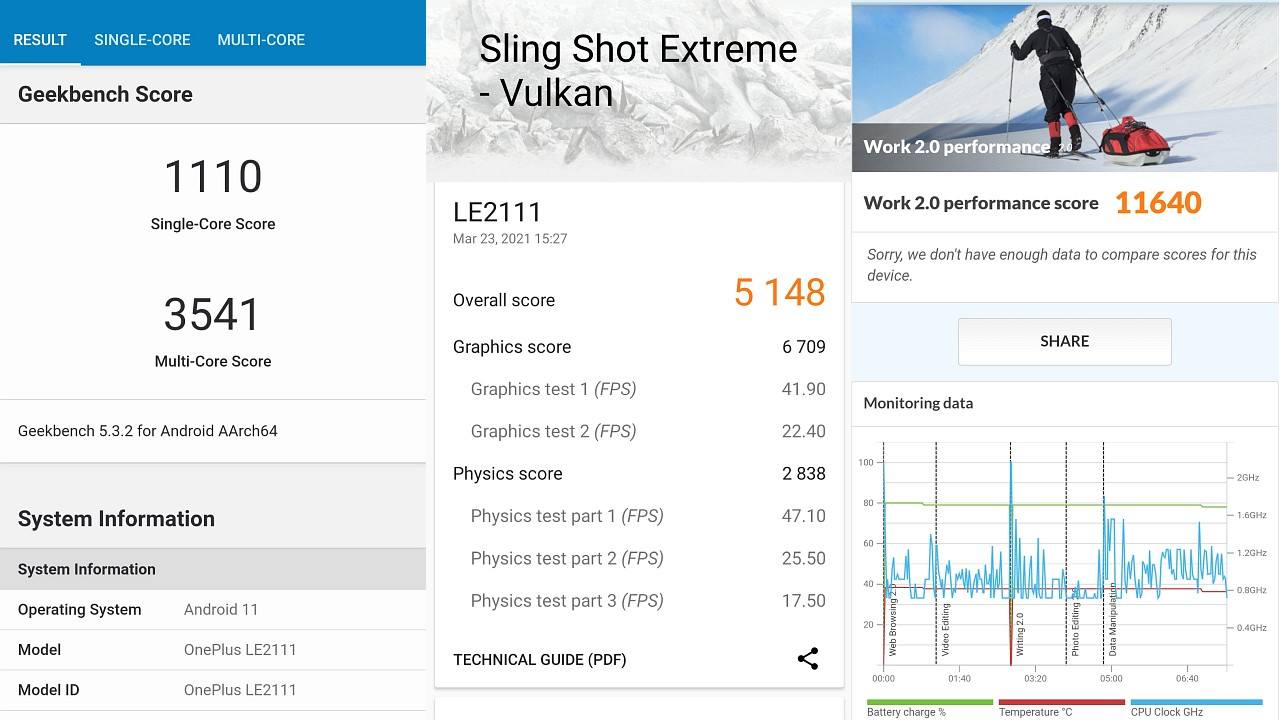
Benchmark results
The phone did get a little warm after 30 minutes of gaming, but it was nothing alarming. The dual stereo speakers (earpiece and speakers at the bottom) manage to produce good quality output with a decent stereo effect. The phone supports aptX HD and LDAC codecs over Bluetooth 5.2 for better throughput on compatible earphones/headphones. Call quality is perfectly fine, and there’s nothing to complain about in that department either.
In popular performance benchmarks, scores were consistently higher than those of the OnePlus 8T, and were in fact some of the highest we have recorded so far, as was expected of the Snapdragon 888 chip. In Geekbench 5, it recorded a Single-core score of 1,110 (OnePlus 8T: 893) and a Multi-core score of 3,541 (8T: 3169), a jump of 24 percent and 12 percent respectively. In PC Mark Work 2.0, it scored 11640 (8T: 10929) – roughly 6.5 percent higher. The 3DMark Sling Shot Extreme – Vulkan benchmark result also witnessed a 10 percent jump. The Adreno 660 GPU on the OnePlus 9 managed to score 5,148, as opposed to a score of 4,667 that the Adreno 650 could reach on the 8T.
OnePlus 9 battery performance: Decent battery life, insanely fast charging
The OnePlus 9 retains the same 4,500 mAh battery found on the 8T. However, the battery life is slightly lower here, probably because the Snapdragon 888 draws a bit more than the better optimised 865 chip. It still managed to keep the phone running for close to 30 hours of normal use that included a generous amount of messaging and use of social media apps, browsing, a decent amount of calling and clicking a few photos, an hour of watching videos and half an hour of gaming. These are still rather good figures.
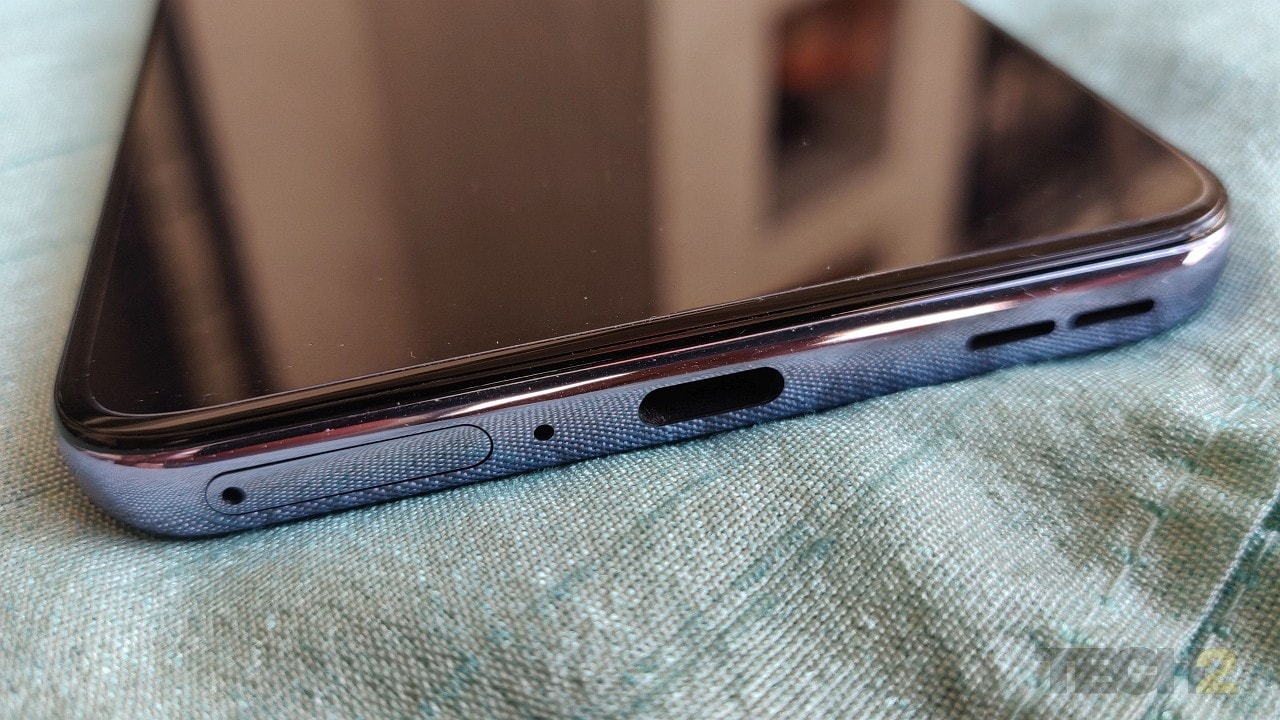
There were no heating issues, either. The charger can also be used to juice up other phones, along with laptops and other devices with a USB-C charging port. Image: Tech2/Ameya Dalvi
OnePlus has retained the 65 W Warp charger that can do 10V/6.5A, and if anything, the charging time has reduced further. It charges the phone from 0 to 50 percent in 13 minutes flat, and if the 39 minutes full charging time for the 8T wasn’t fast enough, the OnePlus 9 goes from 0 to 100 percent in just 35 minutes. It doesn’t exactly scale the peak in 29 minutes as the company advertises, but 35 minutes is faster than anything with a 4,500 mAh battery we have come across. There were no heating issues, either. The charger can also be used to juice up other phones, along with laptops and other devices with a USB-C charging port. Not everything will charge as quickly, though.

OnePlus has retained the 65 W Warp charger that can do 10V/6.5A, and if anything, the charging time has reduced further. Image: Tech2/Ameya Dalvi
OnePlus 9 Camera performance: Improvements in certain areas and a dip in some
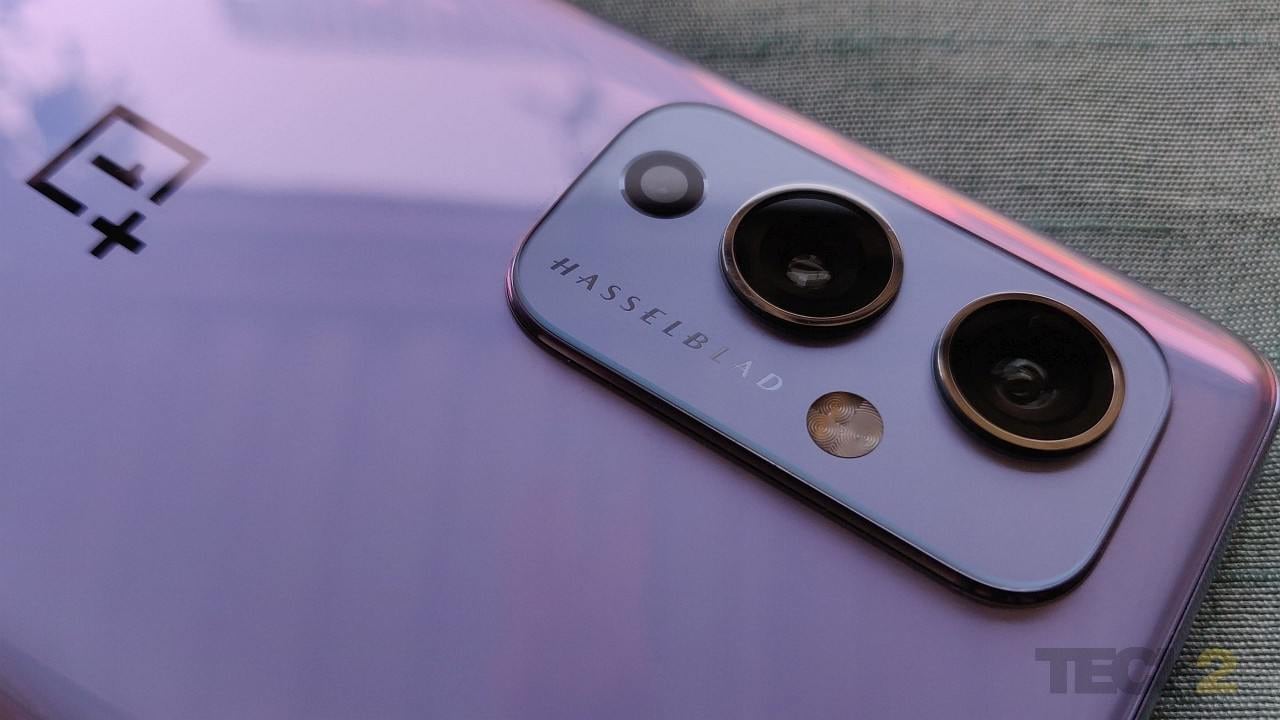
While the positioning of the rear camera module is similar to the 8T’s, the number of lenses and their alignment are both different. Image: Tech2/Ameya Dalvi
The company has opted for three rear cameras on the OnePlus 9 as opposed to four on the OnePlus 8T. You get a 48 MP primary camera with a Sony IMX689 sensor but missing one key feature for the first time since the OnePlus 5T – Optical Image Stabilisation (OIS). The second camera is a 50 MP ultra-wide shooter with a Sony IMX766 sensor, one of the better ultra-wide cameras I have come across. This camera can also click macro shots; a feature borrowed from the OnePlus 7T (Review). Hence OnePlus has done away with a dedicated macro camera, which makes sense.
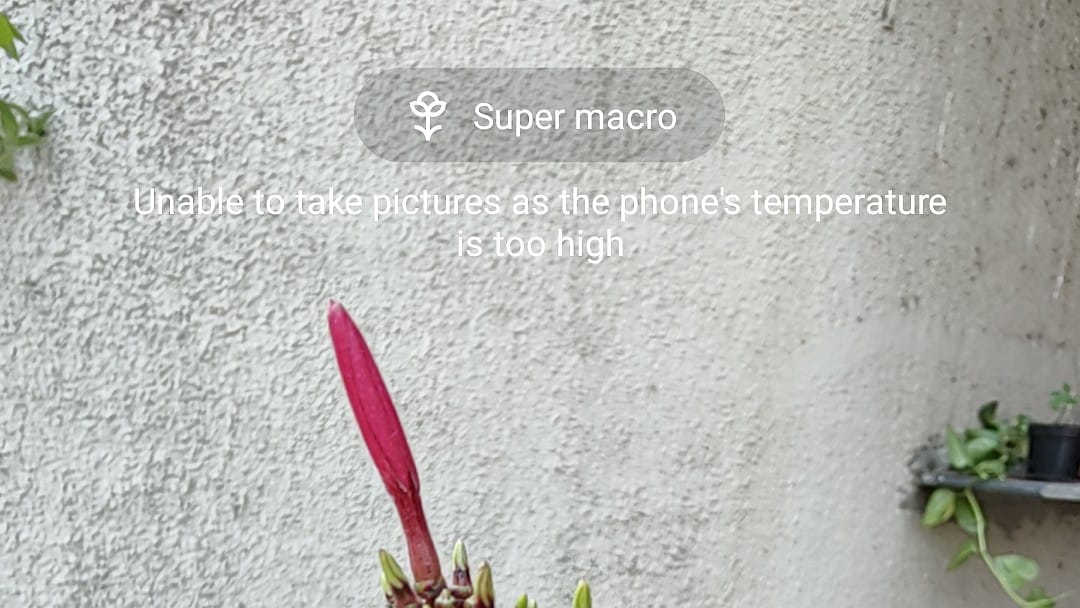
Phone camera stops clicking if the phone temperature goes up. Image: Tech2/Ameya Dalvi
Many would have wished the company brought back another camera present on the 7T – the telephoto – but that isn’t the case. The third camera here is a 2 MP monochrome module that provides a mono filter for images captured using the main camera, and that’s that. It doesn’t act as a depth sensor, either. Pro mode is where Hasselblad does its thing, which I will talk about shortly. Pro mode gives you finer control over the exposure, white balance, shutter speed and more, if you like to play around with the camera settings.
The 16 MP front camera, with a Sony IMX471 sensor, retains its place in the OnePlus 9, too. It is quite competent in well-lit conditions and can capture some sharp selfies with natural looking skin tone. It supports portrait shots as well, and some of the captured portraits come out well, but not all of them. When switched on, a speck of green light goes around the camera and settles into a dot next to it. That makes it easier to spot the camera, and people in the selfie know where to look.
Click here to see the camera samples:
The camera app gives you a quick toggle to switch between regular, ultra-wide and zoom modes. The primary camera captures some crisp shots in well-lit environments with good dynamic range. The colour reproduction, although not perfect, is a lot closer to being natural as compared to previous generation OnePlus phones. Captured images look sharp with a good amount of detail, and there’s still enough vibrance in colours, especially in good light. Ironically, this better colour reproduction probably has nothing to do with Hasselblad, as their tuning kicks in only in Pro mode.
The 50 MP ultrawide camera here is one of the best I have come across in phones under Rs 50,000. It captures 12 MP pixel-binned shots that have incredibly good colours and detail. Edge distortion is almost non-existent. This camera doubles up as a macro camera, too, and lets you click close-ups from up to 4 cm. The quality of macro shots is way better than those taken by the dedicated 2 MP and 5 MP macro cameras on its predecessors. The OnePlus 7T used to do just that with good results. I wonder why they did away with this arrangement on the OnePlus 8 and 8T.
Portrait mode works well here even without a depth sensor, which I believe to be a redundant camera since 2019. The images come out good, be it featuring human subjects or other objects, but the background blur feels a bit too pronounced and unnatural. There is no way to adjust the level of blur. Better to click a couple of shots for backup, as the subject tends to go out of focus at times. Speaking of focus, the main camera did have a few focusing issues initially, but a couple of updates later, the problem was a lot less frequent. However, it still occasionally struggles to focus on distant objects, even in normal mode.
Moving on to zoomed shots, there is no telephoto camera on the OnePlus 9, nor did the 8T have one. However, the latter employed a smart technique that resulted in sharp 2X zoom shots that were way better than typical digitally-zoomed images. When using 2X zoom, the 8T would capture the image in 48 MP mode, and then crop the specific section of the image, resulting in a superior output. Inexplicably, OnePlus has done away with this technique in the 9, and what you get are below-par digitally-zoomed shots. On top of that, the absence of OIS can be strongly felt here, as the slightest of shakes results in more blur.
Low-light photography on the OnePlus 9 is more than decent, with the main camera as well as with the ultrawide shooter. It gains well and makes images brighter, even when not using Nightscape mode. There is a bit of noise, but there is also a good amount of detail in captured shots with good colour reproduction. Nightscape mode improves things further if the light is really low, and is slightly quicker than before to process the images. Though it is available, don’t bother using zoom in low light; the captured images are too soft and have poor detail.
Last but not the least, the Pro mode, where Hasselblad supposedly plays a part. As I mentioned earlier, Pro mode gives you control over three major functions – exposure, white balance and shutter speed. If you know how to use them, you can bring about a certain degree of improvement in captured images, but the difference isn’t massive. Again, the colours are quite good, but after exchanging notes with a colleague, it seemed that the Pro mode images were no better than those captured by the OnePlus 8 Pro, which was never touched by Hasselblad. So frankly, it is hard to say if the legendary camera maker has any substantial impact on the camera performance of OnePlus 9. It probably works on the 9 Pro, but it’s just Hassel-blah here.
The rear cameras on the OnePlus 9 can record videos in 8K resolution at 30 fps, and in 1080p and 4K resolution at 30 or 60 fps. Slow motion 1080p and 720p videos can be recorded at 240 and 480 fps respectively. It also lets you record time-lapse videos at 30 fps in Full HD or 4K resolution. Captured 4K and 1080p footage looks sharp and stabilised, courtesy of EIS (electronic image stabilisation), and displays good colours, too. I did not have the right equipment at the time of testing to judge the 8K footage.
OS and user interface: Oxygen OS + Android 11 remains a great partnership
As expected, the OnePlus 9 runs OxygenOS 11 based on Android 11. We have already seen that combination on the OnePlus 8T, and we are extremely fond of it. OxygenOS 11 continues to be the best Android UI around. It is clean, stutter-free, free of ads and with little bloatware. It adds a handful of useful enhancements without deviating too far from stock Android UI. Since the Nord, OnePlus has opted for Google dialler, contacts and messaging (SMS) apps instead of its own, and that trend continues here.
What I like about OxygenOS 11 is how it strives to facilitate single-handed operation. Right from the settings menu to compatible apps, the content starts from the middle of the screen where it’s a lot easier to reach with the thumb. Once you start scrolling, it utilises the rest of the screen space above. You don’t have to bother stretching your thumb to the top of the screen to tap on anything – you can simply drag it down within your reach. This simple approach makes life convenient indeed.
Final words: Too big a premium to pay for a handful of improvements
The OnePlus 9 sells in India for Rs 49,999 for the 8 GB RAM / 128GB storage variant and Rs 54,999 for its 12 GB RAM variant with 256 GB storage, and you get a one-year warranty with it. That’s a good Rs 7,000 to Rs 9,000 more expensive than the OnePlus 8T with a similar RAM and storage configuration. I don’t have a problem with the company increasing the price of new phones if there are some significant improvements, but that’s not the case here. On the contrary, OnePlus has cut a few corners, a fact made apparent by the plastic frame and lack of OIS on the 9.
Yes, it does have a faster processor, and there is an overall improvement in camera performance, especially the colour reproduction. But the Hasselblad branding is just a marketing gimmick as of now, and the absence of OIS does hamper its performance in certain areas. All said and done, does the OnePlus 9 warrant the hefty premium? I don’t think so. The phone isn’t bad, but not one I would want to pay Rs 50,000 for. I think the company has repeated the mistake it made with the OnePlus 8 (Review), and the price is a good Rs 5,000-10,000 more than it should be. Something closer to the 8T would have been ideal. Since that’s not the case, I would still recommend the OnePlus 8T over the OnePlus 9, or even the OnePlus 8 Pro, which is available within the same range.
Find latest and upcoming tech gadgets online on Tech2 Gadgets. Get technology news, gadgets reviews & ratings. Popular gadgets including laptop, tablet and mobile specifications, features, prices, comparison.

Post a Comment